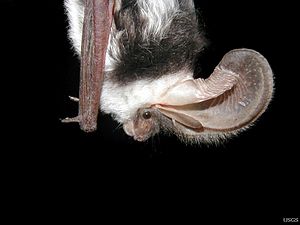Spotted bat
| Spotted bat | ||||||||||||
|---|---|---|---|---|---|---|---|---|---|---|---|---|

Spotted bat ( Euderma maculatum ) |
||||||||||||
| Systematics | ||||||||||||
|
||||||||||||
| Scientific name of the genus | ||||||||||||
| Euderma | ||||||||||||
| H. Allen , 1892 | ||||||||||||
| Scientific name of the species | ||||||||||||
| Euderma maculatum | ||||||||||||
| ( Allen , 1891) |
The spotted bat ( Euderma maculatum ) is a species of bat from the smooth-nosed family (Vespertilionidae). It is the only species in the genus Euderma . She lives in western North America (in British Columbia , the western USA and northwestern Mexico ).
description
The fur of the spotted bat is dark brown to black, on each shoulder and on the back of the trunk it has a noticeable white spot. The very large, gray-colored ears up to 50 millimeters long are striking. The wings are also colored gray, the face is black. These bats reach a head body length of 60 to 77 millimeters, a tail length of 47 to 51 millimeters and a weight of around 15 grams.
Way of life
Spotted bats are found in a number of habitats, but prefer open terrain such as deserts and marshland. They are loners and usually sleep alone in crevices, sometimes in buildings. Like most bats, they are nocturnal, they search for food all night long, but do not go very far from their roost. The animals should not know any territorial behavior, as the territories of the individual animals often overlap over a large area.
The diet of these bats consists primarily of insects such as moths and short-antennae terrors . Their very low frequencies (9 to 12 kilohertz), which they use for echo location , are striking .
Reproduction
Little is known about reproduction. The female usually gives birth to a single young in June. Suckling females were observed well into August.
threat
In general, this bat is considered rare and its range is very fragmented. This is likely to be related to their high demands on the sleeping space. Its exact range is also not known, for example it was not found until the 1980s that it also occurs in southern Canada and in some US states such as Oregon and Colorado , where it had not been observed until then. The exact degree of risk is not known.
Web links
- Illustration
- Euderma maculatum inthe IUCN 2013 Red List of Threatened Species . Posted by: Arroyo-Cabrales, J. & Ticul Alvarez Castaneda, S., 2008. Retrieved October 13, 2013.
literature
- Ronald M. Nowak: Walker's Mammals of the World . Johns Hopkins University Press, 1999 ISBN 0801857899